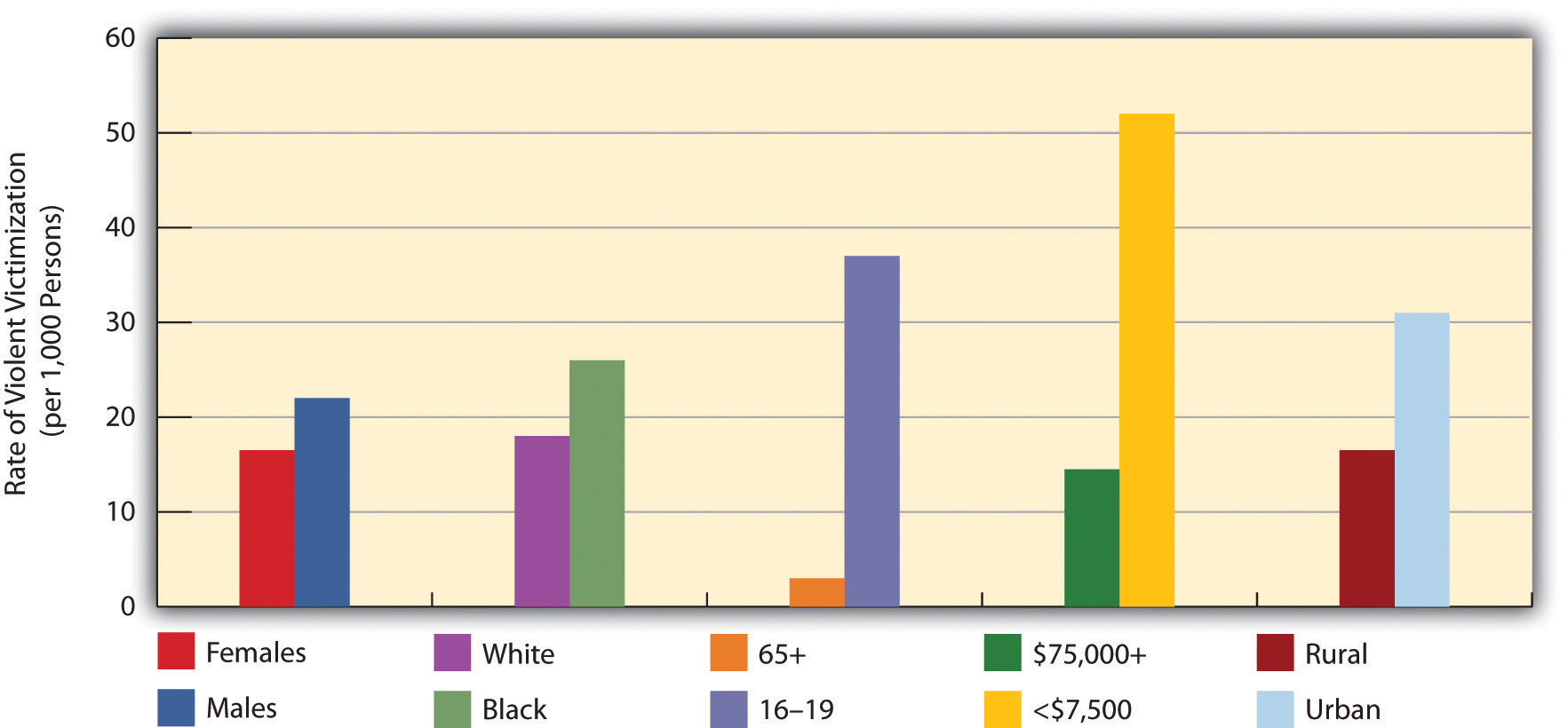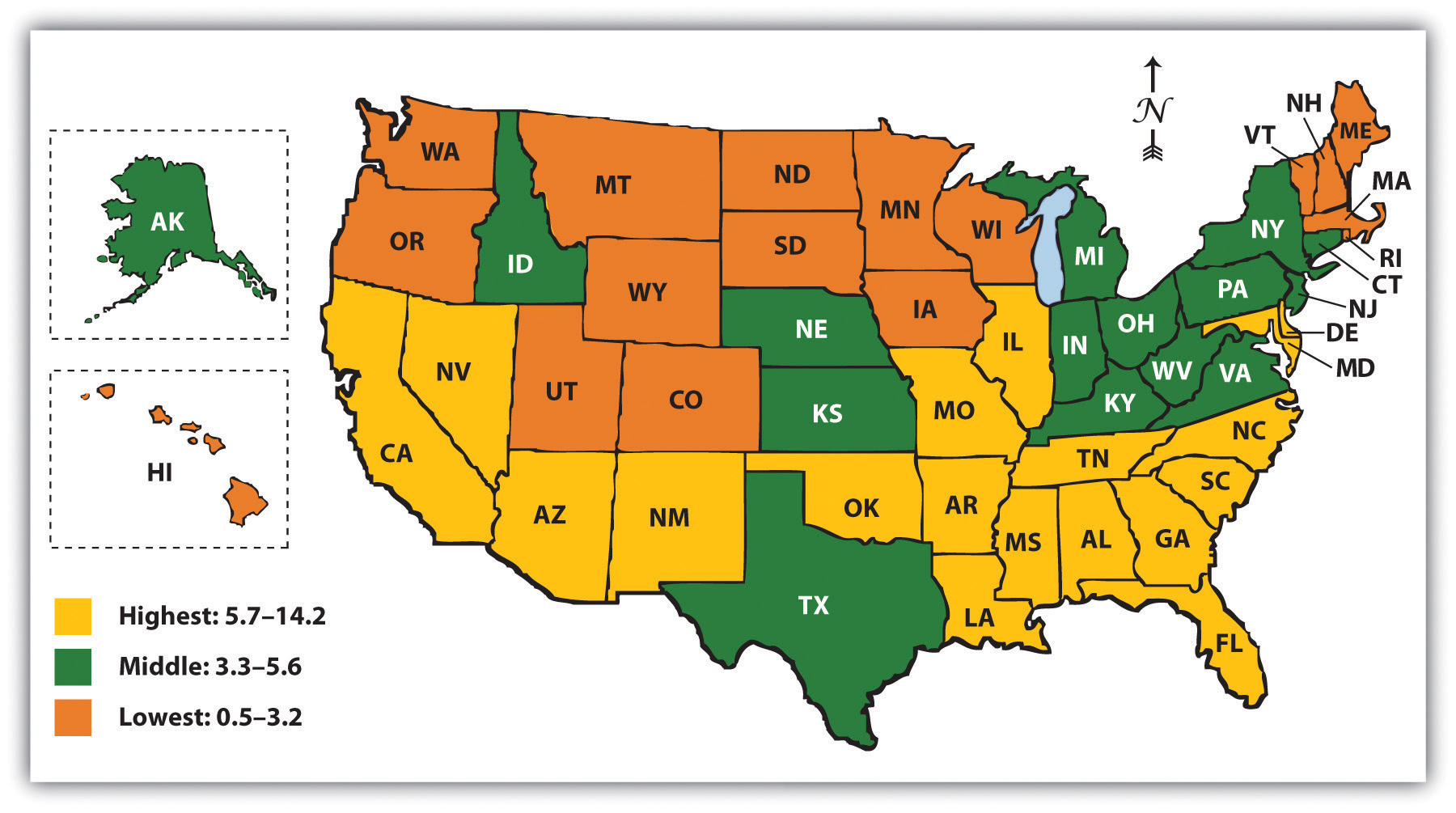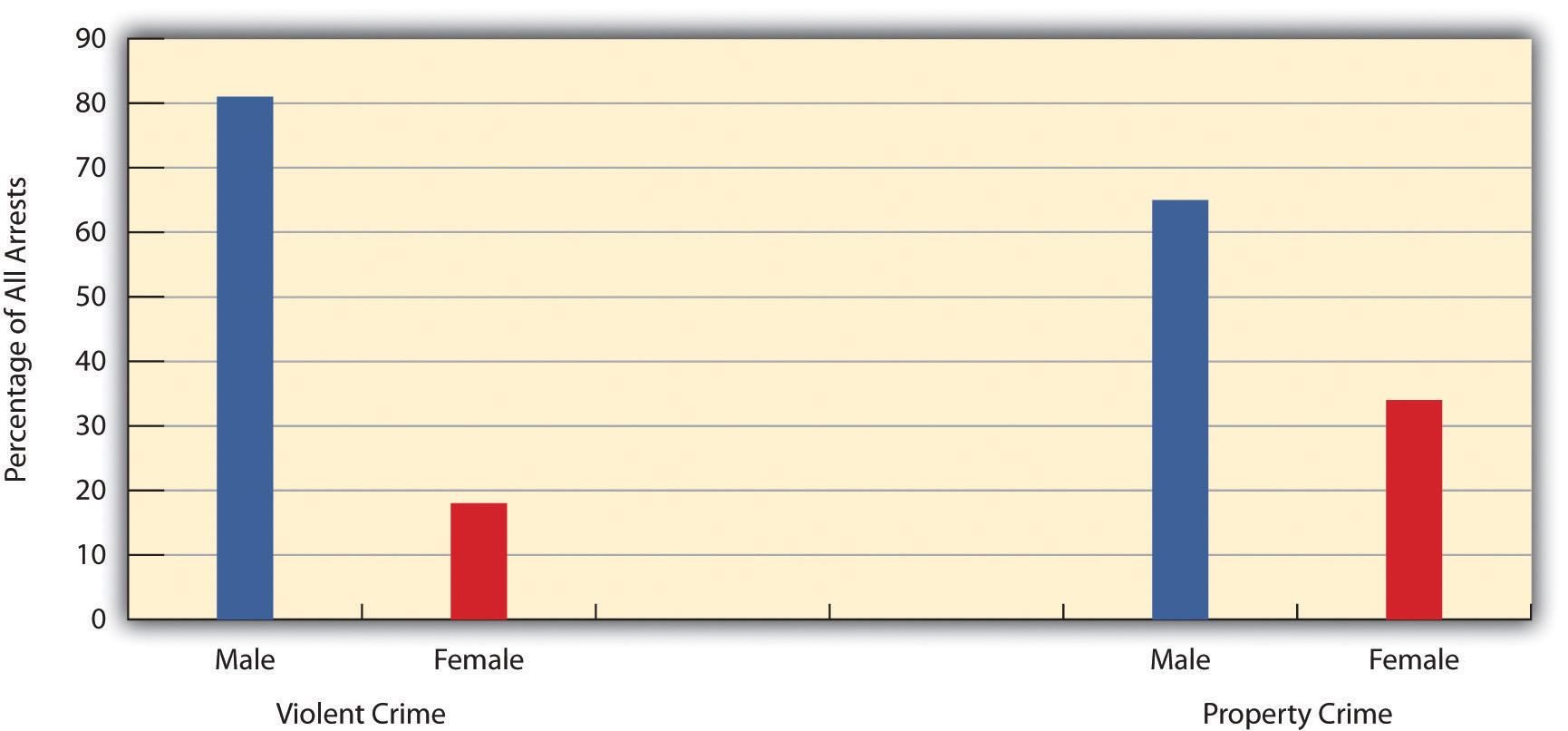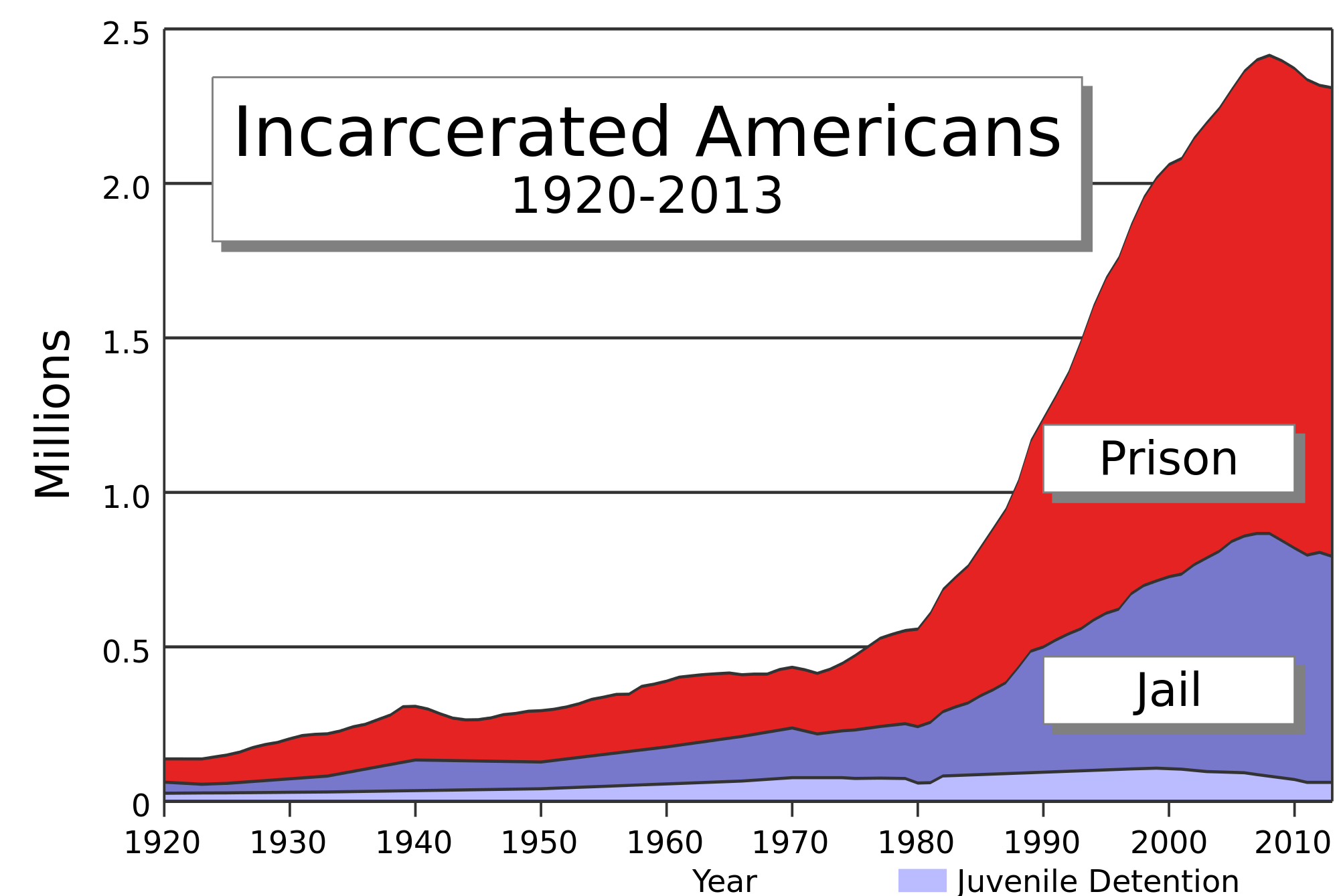8.2: Crime
- Page ID
- 3518
\( \newcommand{\vecs}[1]{\overset { \scriptstyle \rightharpoonup} {\mathbf{#1}} } \)
\( \newcommand{\vecd}[1]{\overset{-\!-\!\rightharpoonup}{\vphantom{a}\smash {#1}}} \)
\( \newcommand{\dsum}{\displaystyle\sum\limits} \)
\( \newcommand{\dint}{\displaystyle\int\limits} \)
\( \newcommand{\dlim}{\displaystyle\lim\limits} \)
\( \newcommand{\id}{\mathrm{id}}\) \( \newcommand{\Span}{\mathrm{span}}\)
( \newcommand{\kernel}{\mathrm{null}\,}\) \( \newcommand{\range}{\mathrm{range}\,}\)
\( \newcommand{\RealPart}{\mathrm{Re}}\) \( \newcommand{\ImaginaryPart}{\mathrm{Im}}\)
\( \newcommand{\Argument}{\mathrm{Arg}}\) \( \newcommand{\norm}[1]{\| #1 \|}\)
\( \newcommand{\inner}[2]{\langle #1, #2 \rangle}\)
\( \newcommand{\Span}{\mathrm{span}}\)
\( \newcommand{\id}{\mathrm{id}}\)
\( \newcommand{\Span}{\mathrm{span}}\)
\( \newcommand{\kernel}{\mathrm{null}\,}\)
\( \newcommand{\range}{\mathrm{range}\,}\)
\( \newcommand{\RealPart}{\mathrm{Re}}\)
\( \newcommand{\ImaginaryPart}{\mathrm{Im}}\)
\( \newcommand{\Argument}{\mathrm{Arg}}\)
\( \newcommand{\norm}[1]{\| #1 \|}\)
\( \newcommand{\inner}[2]{\langle #1, #2 \rangle}\)
\( \newcommand{\Span}{\mathrm{span}}\) \( \newcommand{\AA}{\unicode[.8,0]{x212B}}\)
\( \newcommand{\vectorA}[1]{\vec{#1}} % arrow\)
\( \newcommand{\vectorAt}[1]{\vec{\text{#1}}} % arrow\)
\( \newcommand{\vectorB}[1]{\overset { \scriptstyle \rightharpoonup} {\mathbf{#1}} } \)
\( \newcommand{\vectorC}[1]{\textbf{#1}} \)
\( \newcommand{\vectorD}[1]{\overrightarrow{#1}} \)
\( \newcommand{\vectorDt}[1]{\overrightarrow{\text{#1}}} \)
\( \newcommand{\vectE}[1]{\overset{-\!-\!\rightharpoonup}{\vphantom{a}\smash{\mathbf {#1}}}} \)
\( \newcommand{\vecs}[1]{\overset { \scriptstyle \rightharpoonup} {\mathbf{#1}} } \)
\( \newcommand{\vecd}[1]{\overset{-\!-\!\rightharpoonup}{\vphantom{a}\smash {#1}}} \)
\(\newcommand{\avec}{\mathbf a}\) \(\newcommand{\bvec}{\mathbf b}\) \(\newcommand{\cvec}{\mathbf c}\) \(\newcommand{\dvec}{\mathbf d}\) \(\newcommand{\dtil}{\widetilde{\mathbf d}}\) \(\newcommand{\evec}{\mathbf e}\) \(\newcommand{\fvec}{\mathbf f}\) \(\newcommand{\nvec}{\mathbf n}\) \(\newcommand{\pvec}{\mathbf p}\) \(\newcommand{\qvec}{\mathbf q}\) \(\newcommand{\svec}{\mathbf s}\) \(\newcommand{\tvec}{\mathbf t}\) \(\newcommand{\uvec}{\mathbf u}\) \(\newcommand{\vvec}{\mathbf v}\) \(\newcommand{\wvec}{\mathbf w}\) \(\newcommand{\xvec}{\mathbf x}\) \(\newcommand{\yvec}{\mathbf y}\) \(\newcommand{\zvec}{\mathbf z}\) \(\newcommand{\rvec}{\mathbf r}\) \(\newcommand{\mvec}{\mathbf m}\) \(\newcommand{\zerovec}{\mathbf 0}\) \(\newcommand{\onevec}{\mathbf 1}\) \(\newcommand{\real}{\mathbb R}\) \(\newcommand{\twovec}[2]{\left[\begin{array}{r}#1 \\ #2 \end{array}\right]}\) \(\newcommand{\ctwovec}[2]{\left[\begin{array}{c}#1 \\ #2 \end{array}\right]}\) \(\newcommand{\threevec}[3]{\left[\begin{array}{r}#1 \\ #2 \\ #3 \end{array}\right]}\) \(\newcommand{\cthreevec}[3]{\left[\begin{array}{c}#1 \\ #2 \\ #3 \end{array}\right]}\) \(\newcommand{\fourvec}[4]{\left[\begin{array}{r}#1 \\ #2 \\ #3 \\ #4 \end{array}\right]}\) \(\newcommand{\cfourvec}[4]{\left[\begin{array}{c}#1 \\ #2 \\ #3 \\ #4 \end{array}\right]}\) \(\newcommand{\fivevec}[5]{\left[\begin{array}{r}#1 \\ #2 \\ #3 \\ #4 \\ #5 \\ \end{array}\right]}\) \(\newcommand{\cfivevec}[5]{\left[\begin{array}{c}#1 \\ #2 \\ #3 \\ #4 \\ #5 \\ \end{array}\right]}\) \(\newcommand{\mattwo}[4]{\left[\begin{array}{rr}#1 \amp #2 \\ #3 \amp #4 \\ \end{array}\right]}\) \(\newcommand{\laspan}[1]{\text{Span}\{#1\}}\) \(\newcommand{\bcal}{\cal B}\) \(\newcommand{\ccal}{\cal C}\) \(\newcommand{\scal}{\cal S}\) \(\newcommand{\wcal}{\cal W}\) \(\newcommand{\ecal}{\cal E}\) \(\newcommand{\coords}[2]{\left\{#1\right\}_{#2}}\) \(\newcommand{\gray}[1]{\color{gray}{#1}}\) \(\newcommand{\lgray}[1]{\color{lightgray}{#1}}\) \(\newcommand{\rank}{\operatorname{rank}}\) \(\newcommand{\row}{\text{Row}}\) \(\newcommand{\col}{\text{Col}}\) \(\renewcommand{\row}{\text{Row}}\) \(\newcommand{\nul}{\text{Nul}}\) \(\newcommand{\var}{\text{Var}}\) \(\newcommand{\corr}{\text{corr}}\) \(\newcommand{\len}[1]{\left|#1\right|}\) \(\newcommand{\bbar}{\overline{\bvec}}\) \(\newcommand{\bhat}{\widehat{\bvec}}\) \(\newcommand{\bperp}{\bvec^\perp}\) \(\newcommand{\xhat}{\widehat{\xvec}}\) \(\newcommand{\vhat}{\widehat{\vvec}}\) \(\newcommand{\uhat}{\widehat{\uvec}}\) \(\newcommand{\what}{\widehat{\wvec}}\) \(\newcommand{\Sighat}{\widehat{\Sigma}}\) \(\newcommand{\lt}{<}\) \(\newcommand{\gt}{>}\) \(\newcommand{\amp}{&}\) \(\definecolor{fillinmathshade}{gray}{0.9}\)Objectives
- Explain the major types of crimes that are committed in the United States.
- Analyze the effects of crime on society.
- Explain the characteristics of the American criminal- justice system.
Universal Generalizations
- Crime is committed in every society.
- In the United States, crime affects everyone some as victims and some as criminals.
- The majority of Americans are affected by crime as bystanders.
- Many consider crime to be a significant social problem.
- Most victims of violence are African Americans.
- Property crimes are much more common than violent crimes.
Guiding Questions
- Why do some people commit acts of crime?
- How does society look upon people who commit crimes?
- What are the main types of crimes committed in the U.S.?
- What is the purpose of crime statistics?
- How does organized crime affect the stability of society?
- What role does the American criminal- justice system play in stabilizing society?
Crime and Criminals
In the United States, one way or another people are affected by crime. Some people are victims others are criminals and some are both. Still, the majority of Americans are affected by crime as bystanders. Many people consider crime to play a significant role in societal problems.
Although deviance is a violation of social norms, it’s not always punishable, and it’s not necessarily bad. Crime, on the other hand, is a behavior that violates official law and is punishable through formal sanctions. Walking to class backwards is deviant behavior. Driving with a blood alcohol percentage over the state’s limit is a crime. Like other forms of deviance, however, ambiguity exists concerning what constitutes a crime and whether all crimes are, in fact, “bad” and deserve punishment. For example, during the 1960s, civil rights activists often violated laws intentionally as part of their effort to bring about racial equality. In hindsight, we recognize that the laws that deemed many of their actions crimes—for instance, Rosa Parks taking a seat in the “whites only” section of the bus—were inconsistent with social equality.
All societies have informal and formal ways of maintaining social control. Within these systems of norms, societies have legal codes that maintain formal social control through laws, which are rules adopted and enforced by a political authority. Those who violate these rules incur negative formal sanctions. Normally, punishments are relative to the degree of the crime and the importance to society of the value underlying the law. As we will see, however, there are other factors that influence criminal sentencing.
Types of Crimes Overview
Not all crimes are given equal weight. Society generally socializes its members to view certain crimes as more severe than others. For example, most people would consider murdering someone to be far worse than stealing a wallet and would expect a murderer to be punished more severely than a thief. In modern American society, crimes are classified as one of two types based on their severity. Violent crimes (also known as “crimes against a person”) are based on the use of force or the threat of force. Rape, murder, and armed robbery fall under this category. Nonviolent crimes involve the destruction or theft of property but do not use force or the threat of force. Because of this, they are also sometimes called “property crimes.” Larceny, car theft, and vandalism are all types of nonviolent crimes. If you use a crowbar to break into a car, you are committing a nonviolent crime; if you mug someone with the crowbar, you are committing a violent crime.
When we think of crime, we often picture street crime, or offenses committed by ordinary people against other people or organizations, usually in public spaces. An often-overlooked category is corporate crime-white collar crime, crime committed by white-collar workers in a business environment. Embezzlement, insider trading, and identity theft are all types of corporate crime. Although these types of offenses rarely receive the same amount of media coverage as street crimes, they can be far more damaging. The current economic recession in the United States is the ultimate result of a financial collapse triggered by corporate crime.
An often-debated third type of crime is a victimless crime. These are called victimless because the perpetrator is not explicitly harming another person. As opposed to battery or theft, which clearly have a victim, a crime like drinking a beer at age 20 or selling a sexual act does not result in injury to anyone other than the individual who engages in them, although they are illegal. While some claim acts like these are victimless, others argue that they actually do harm society. Prostitution may foster abuse toward women by clients or pimps. Drug use may increase the likelihood of employee absences. Such debates highlight how the deviant and criminal nature of actions develops through ongoing public discussion.
Hate Crimes
Attacks based on a person’s race, religion, or other characteristics are known as hate crimes. Hate crimes in the United States evolved from the time of early European settlers and their violence toward Native Americans. Such crimes weren’t investigated until the early 1900s when the Ku Klux Klan began to draw national attention for its activities against blacks and other groups. The term “hate crime,” however, didn’t become official until the 1980s (Federal Bureau of Investigations 2011).
An average of 195,000 Americans fall victim to hate crimes each year, but fewer than five percent ever report the crime (FBI 2010). The majority of hate crimes are racially motivated, but many are based on religious (especially anti-Semitic) prejudice (FBI 2010). After incidents like the murder of Matthew Shepard in Wyoming in 1998 and the tragic suicide of Rutgers University student Tyler Clementi in 2010, there has been a growing awareness of hate crimes based on sexual orientation.

Crime and Public Opinion
One thing we know is that the American public is very concerned about crime. In a 2009 Gallup Poll, about 55% said crime is an “extremely” or “very” serious problem in the United States, and in other national surveys, about one-third of Americans said they would be afraid to walk alone in their neighborhoods at night (Maguire & Pastore, 2009; Saad, 2008). Maguire, K., & Pastore, A. L. (2009). Sourcebook of criminal justice statistics. Retrieved from http://www.albany.edu/sourcebook; Saad, L. (2008). Perceptions of crime problems remain curiously negative. Retrieved from http://www.gallup.com/poll/102262/Perceptions-Crime-Problem-Remain-Curiously-Negative.aspx
Crime Statistics
What crimes are people in the United States most likely to commit, and who is most likely to commit them? To understand criminal statistics, you must first understand how these statistics are collected.
Since 1930, the Federal Bureau of Investigation has been collecting and publishing an archive of crime statistics. Known as Uniform Crime Reports (UCR), these annual publications contain data from approximately 17,000 law enforcement agencies (FBI 2011). Although the UCR contains comprehensive data on police reports, it fails to take into account the fact that many crimes go unreported due to the victim’s unwillingness to report them, largely based on fear, shame, or distrust of the police. The quality of the data collected by the UCR also varies greatly. Because officers’ approaches to gathering victims’ accounts frequently differed, important details were not always asked for or reported (Cantor and Lynch 2000).
To offset this publication, in 1973 the U.S. Bureau of Justice Statistics began to publish a separate report known as the National Crime Victimization Survey (NCVS). The NCVS is a self-report study. A self-report study is a collection of data acquired using voluntary response methods, such as questionnaires or telephone interviews. Each year, survey data are gathered from approximately 135,000 people in the United States on the frequency and type of crime they experience in their daily lives (BJS 2011). The surveys are thorough, providing a wider scope of information than was previously available. This allows researchers to examine crime from more detailed perspectives and to analyze the data based on factors such as the relationship between victims and offenders, the consequences of the crimes, and substance abuse involved in the crimes. Demographics are also analyzed, such as age, race, gender, location, and income level (National Archive of Criminal Justice Data 2010). The NCVS reports a higher rate of crime than the UCR.
Though the NCVS is a critical source of statistical information, disadvantages exist. “Non-response,” or a victim’s failure to participate in the survey or a particular question, is among them. The inability to contact important demographics, such as those who don’t have access to phones or frequently relocate, also skews the data. For those who participate, memory issues can be problematic for the data sets. Some victims’ recollection of the crimes can be inaccurate or simply forgotten over time (Cantor and Lynch 2000).
While neither of these publications can take into account all of the crimes committed in the country, some general trends may be noted. Crime rates were on the rise after 1960, but following an all-time high in the 1980s and 1990s, rates of violent and non-violent crimes once again started to decline.
In 2009, approximately 4.3 million violent crimes occurred in the United States, the majority being assault and robbery. An estimated 15.6 million nonviolent crimes took place, the most common being larceny. Less than half of all violent and nonviolent crimes were reported to the police (BJS 2010).
In general, demographic patterns tend to correlate with crime: factors such as sex and socioeconomic status may relate to a person’s chances of being a crime victim or a perpetrator. Women are much more likely than men to be victimized by someone they know, such as a family member or friend, and one-fourth of all nonfatal attacks on women are carried out by a romantic partner (BJS 2011b).
www.fbi.gov/news/stories/2013/september/latest-crime-stats-released/image/graphic-snapshot-of-property-crimes-in-u.s
www.fbi.gov/news/stories/2013/september/latest-crime-stats-released/image/graphic-snapshot-of-violent-crimes-in-u.s

Conventional Crime

Conventional crime encompasses the violent and property offenses listed previously that worry average citizens more than any other type of crime. As Figure 8.2.4 "Number of Crimes: Uniform Crime Reports and National Crime Victimization Survey, 2009" indicated, more than 20 million violent and property victimizations occurred in the United States in 2009. These offenses included some 15,240 murders; 126,000 rapes and sexual assaults; 534,000 robberies; and 823,000 aggravated assaults. Even more property crime occurs: 3.1 million burglaries, 11.8 million larcenies, and 736,000 motor vehicle thefts (Pastore & Maguire, 2010). Pastore, A. L., & Maguire, K. (2010). Sourcebook of criminal justice statistics. Retrieved from http://www.albany.edu/sourcebook The NCVS estimates that the crimes it measures cost their victims almost $20 billion each year in property losses, medical expenses, and time lost from work.
Figure 8.2.4 "Number of Crimes: Uniform Crime Reports and National Crime Victimization Survey, 2009" lists the number of violent and property crimes as reported by the UCR (see earlier) and estimated by the NCVS. Note that these two crime sources do not measure exactly the same crimes. For example, the NCVS excludes commercial crimes such as shoplifting, while the UCR includes them. The NCVS includes simple assaults (where someone receives only a minor injury), while the UCR excludes them. These differences notwithstanding, we can still see that the NCVS estimates about twice as many crimes as the UCR reports to us.
| Type of crime | UCR | NCVS |
|---|---|---|
| Violent crime | 1,318,398 | 4,343,450 |
| Property crime | 9,320,971 | 15,713,720 |
| Total | 10,639,369 | 20,057,170 |
Generally, African Americans and other people of color are more likely than whites to be victims of conventional crime, poor people more likely than wealthy people, men more likely than women (excluding rape and sexual assault), and urban residents more likely than rural residents. To illustrate these differences, Figure 8.2.5 "Correlates of Violent Crime Victimization, 2008" presents some relevant comparisons for violent crime victimization.

As this figure illustrates, violent crime is more common in urban areas than in rural areas. It varies geographically in at least one other respect, and that is among the regions of the United States. In general, violent crime is more common in the South and West than in the Midwest or Northeast. Figure 8.2.6 "U.S. Homicide Rates, 2008" depicts this variation for homicide rates. Louisiana has the highest homicide rate, 14.24 homicides per 100,000 residents, and New Hampshire has the lowest rate, 1.1 per 100,000 residents. Although homicide is thankfully a rare occurrence, it is much more common in Louisiana than in New Hampshire, and it is generally more common in the South and West than in other regions. Scholars attribute the South’s high rate of homicide and other violent crime to several factors, among them a subculture of violence, its history of slavery and racial violence, and its high levels of poverty (Lee, Bankston, Hayes, & Thomas, 2007). Lee, M. R., Bankston, W. B., Hayes, T. C., & Thomas, S. A. (2007). Revisiting the Southern subculture of violence. The Sociological Quarterly, 48, 253–275.

When it comes to crime, we fear strangers much more than people we know, but NCVS data suggest our fear is somewhat misplaced (Truman & Rand, 2010). Truman, J. L., & Rand, M. R. (2010). Criminal victimization, 2009. Washington, DC: Bureau of Justice Statistics, U.S. Department of Justice. In cases of assault, rape, or robbery, the NCVS asks respondents whether they knew the offender. Strangers commit only about 42% of these offenses, meaning that 58% of the offenses, or well over half, are committed by someone the victim knows. There is also a gender difference in this area: 68% of women victims are attacked by someone they know (usually a man), compared to only 45% of male victims. Women have more to fear from men they know than from men they do not know.
Another important fact about conventional crime is that most of it is intraracial, meaning that the offender and victim are usually of the same race. For example, 84% of all single offender–single victim homicides in 2009 involved persons who were either both white or both African American (Federal Bureau of Investigation, 2010).Federal Bureau of Investigation. (2010). Crime in the United States, 2009. Washington, DC: Author.
Who is most likely to commit conventional crime? As noted earlier, males are more likely than females to commit it (see Figure 8.2.7 "Gender and Arrest, 2008") because of gender differences in socialization. Opportunity may also matter, as during adolescence boys have more freedom than girls to be outside the home and to get into trouble.

Despite much controversy over what racial differences in arrest mean, African Americans have higher rates of arrest than whites for conventional crime. Criminologists generally agree that these rates indicate higher rates of offending (Walker, Spohn, & DeLone, 2007). Walker, S., Spohn, C., & DeLone, M. (2007). The color of justice: Race, ethnicity, and crime in America. Belmont, CA: Wadsworth. Although African Americans are about 13% of the U.S. population, they accounted for about 39% of all arrests for violent crime in 2009 and 30% of all arrests for property crime (Federal Bureau of Investigation, 2010).Federal Bureau of Investigation. (2010). Crime in the United States, 2009. Washington, DC: Author. Much of these higher crime rates stem from the fact that African Americans are much poorer than whites on average and much more likely to live in the large cities with high crime rates and in the neighborhoods in these cities with the highest crime rates (McNulty & Bellair, 2003).McNulty, T. L., & Bellair, P. E. (2003). Explaining racial and ethnic differences in serious adolescent violent behavior. Criminology, 41, 709–748. If whites lived under the same conditions, their crime rates would be much higher as well.
Social class also makes a difference in conventional crime rates. Most people arrested for conventional crime have low education and low incomes. Such class differences in arrest can be explained by several of the explanations of deviance already discussed, including strain theory. Note, however, that wealthier people commit most white-collar crimes. If the question is whether social class affects crime rates, the answer depends on what kind of crime we have in mind.
One final factor affecting conventional crime rates is age. The evidence is very clear that conventional crime is disproportionately committed by people 30 and under. For example, people in the 10–24 age group are about 22% of the U.S. population but account for about 45% of all arrests (Federal Bureau of Investigation, 2010).Federal Bureau of Investigation. (2010). Crime in the United States, 2009. Washington, DC: Author. During adolescence and young adulthood, peer influences are especially strong and “stakes in conventional activities,” to use some sociological jargon, are weak. Once we start working full time and get married, our stakes in society become stronger and our sense of responsibility grows. We soon realize that breaking the law might prove more costly than when we were 15.
White-Collar Crime
White-collar crime is crime committed as part of one’s occupation. It ranges from fraudulent repairs by auto repair shops to corruption in the high-finance industry to unsafe products and workplaces in some of our largest corporations. It also includes employee theft of objects and cash. Have you ever taken something without permission from a place where you worked? Whether or not you have, many people steal from their employees, and the National Retail Federation estimates that employee theft involves some $20 billion annually (National Retail Federation, 2007).National Retail Federation. (2007, June 11). Retail losses hit $41.6 billion last year, according to National Retail Security Survey [Press release]. Retrieved from www.nrf.com/modules.php?name=News&op=viewlive&sp_id=318

White-collar crime also includes health-care fraud, which is estimated to cost some $100 billion a year as, for example, physicians and other health-care providers bill Medicaid for exams and tests that were never done or were unnecessary (Rosoff, Pontell, & Tillman, 2010). Rosoff, S. M., Pontell, H. N., & Tillman, R. (2010). Profit without honor: White-collar crime and the looting of America (5th ed.). Upper Saddle River, NJ: Prentice Hall. And it also involves tax evasion: the IRS estimates that tax evasion costs the government some $300 billion annually, a figure many times greater than the cost of all robberies and burglaries (Montgomery, 2007). Montgomery, L. (2007, April 16). Unpaid taxes tough to recover. The Washington Post, p. A1.
Some of the worst crime is committed by our major corporations (corporate crime). As just one example, price-fixing in the corporate world costs the U.S. public about $60 billion a year (Simon, 2006). Simon, D. R. (2006). Elite deviance. Boston, MA: Allyn & Bacon. Even worse, an estimated 50,000 workers die each year from workplace-related illnesses and injuries that could have been prevented if companies had obeyed regulatory laws and followed known practices for safe workplaces (AFL-CIO, 2007).AFL-CIO. (2007). Death on the job: The toll of neglect. Washington, DC: AFL-CIO. A tragic example of this problem occurred in April 2010, when an explosion in a mining cave in West Virginia killed 29 miners. It was widely thought that a buildup of deadly gases had caused the explosion, and the company that owned the mine had been cited many times during the prior year for safety violations related to proper gas ventilation (Urbina, 2010). Urbina, I. (2010, April 10). No survivors found after West Virginia mine disaster. The New York Times, p. A1.
Corporations also make deadly products. In the 1930s the asbestos industry first realized their product was dangerous but hid the evidence of its danger, which was not discovered until 40 years later. In the meantime, thousands of asbestos workers came down with deadly asbestos-related disease, and the public was exposed to asbestos that was routinely put into buildings until its danger came to light. It is estimated that more than 200,000 people will eventually die from asbestos (Lilienfeld, 1991). Lilienfeld, D. E. (1991). The silence: The asbestos industry and early occupational cancer research—a case study. American Journal of Public Health, 81, 791–800.
Is white-collar crime worse than conventional crime? The evidence seems to say yes. A recent estimate put the number of deaths from white-collar crime annually at about 110,000, compared to “only” 16,000 to 17,000 from homicide. The financial cost of white-collar crime to the public was also estimated at about $565 billion annually, compared to about $18 billion from conventional crime (Barkan, 2012). Barkan, S. E. (2012). Criminology: A sociological understanding (5th ed.). Upper Saddle River, NJ: Prentice Hall. Although we worry about conventional crime much more than white-collar crime, the latter harms the public more in terms of death and financial costs.
Victimless Crime
Victimless crime is illegal behavior in which people willingly engage and in which there are no unwilling victims. The most common examples are drug use, prostitution, pornography, and gambling. Many observers say these crimes are not really victimless, even if people do engage in them voluntarily. For example, many drug users hurt themselves and members of their families from their addiction and the physical effects of taking drugs. Prostitutes put themselves at risk for sexually transmitted diseases and abuse by pimps and customers. Illegal gamblers can lose huge sums of money. Although none of these crimes is truly victimless, the fact that the people involved in them are not unwilling victims makes victimless crime different from conventional crime.
Victimless crime raises controversial philosophical and sociological questions. The philosophical question is this: should people be allowed to engage in behavior that hurts themselves (Meier & Geis, 2007)? Meier, R. F., & Geis, G. (2007). Criminal justice and moral issues. New York, NY: Oxford University Press. For example, our society lets adults smoke cigarettes, even though tobacco use kills several hundred thousand people every year. We also let adults gamble legally in state lotteries, at casinos and racetracks, and in other ways. We obviously let people of all ages eat “fat food” such as hamburgers, candy bars, and ice cream. Few people would say we should prohibit these potentially harmful behaviors. Why, then, prohibit the behaviors we call victimless crime? Some scholars say that any attempt to decide which behaviors are so unsafe or immoral that they should be banned is bound to be arbitrary, and they call for these bans to be lifted. Others say that the state does indeed have a legitimate duty to ban behavior the public considers unsafe or immoral and that the present laws reflect public opinion on which behaviors should be banned.
The sociological question is just as difficult to resolve: do laws against victimless crimes do more harm than good (Meier & Geis, 2007)? Meier, R. F., & Geis, G. (2007). Criminal justice and moral issues. New York, NY: Oxford University Press. Some scholars say these laws in fact do much more harm than good, and they call for the laws to be abolished or at least reconsidered for several reasons: the laws are ineffective even though they cost billions of dollars to enforce, and they lead to police and political corruption and greater profits for organized crime. Laws against drugs further lead to extra violence, as youth gangs and other groups fight each other to corner the market for the distribution of drugs in various neighborhoods. The opponents of victimless crime laws commonly cite the example of Prohibition during the 1920s, where the banning of alcohol led to all of these problems, which in turn forced an end to Prohibition by the early 1930s. If victimless crimes were made legal, opponents add, the government could tax the behaviors now banned and collect billions of additional tax dollars.

Those in favor of laws against victimless crimes cite the danger these behaviors pose for the people engaging in them and for the larger society. If we made drugs legal, they say, even more people would use them, and even more death and illness would occur. Removing the bans against behaviors such as drug use and prostitution, these proponents add, would imply that these behaviors are acceptable in a civil society.
The debate over victimless crimes and victimless crime laws will not end soon, as both sides have several good points to make. One thing that is clear is that our current law enforcement approach is not working. More than 1 million people are arrested annually for drug use and trafficking and other victimless crimes, but there is little evidence that using the law in this manner has lowered people’s willingness to take part in victimless crime behavior (Meier & Geis, 2007). Meier, R. F., & Geis, G. (2007). Criminal justice and moral issues. New York, NY: Oxford University Press. Perhaps it is not too rash to say that a serious national debate needs to begin on the propriety of the laws against victimless crimes to determine what course of action makes the most sense for American society.
Learning From Other Societies
Crime and Punishment in Denmark and the Netherlands
As the text notes, since the 1970s the United States has used a get-tough approach to fight crime; a key dimension of this approach is mandatory sentencing and long prison terms and, as a result, a huge increase in the number of people in prison and jail. Many scholars say this approach has not reduced crime to a great degree and has cost hundreds of billions of dollars.
The experience of Denmark and the Netherlands suggests a different way of treating criminals and dealing with crime. Those nations, like most others in Western Europe, think prison makes most offenders worse and should be used only as a last resort for the most violent and most incorrigible offenders. They also recognize that incarceration is very expensive and much more costly than other ways of dealing with offenders. These concerns have led Denmark, the Netherlands, and other Western European nations to favor alternatives to imprisonment for the bulk of their offenders. These alternatives include the widespread use of probation, community service, and other kinds of community-based corrections. Studies indicate that these alternatives may be as effective as incarceration in reducing recidivism (repeat offending) and cost much less than incarceration. If so, an important lesson from Denmark, the Netherlands, and other nations in Western Europe is that it is possible to keep society safe from crime without using the costly get-tough approach that has been the hallmark of the U.S. criminal justice system since the 1970s. (Bijleveld & Smit, 2005; Dammer & Fairchild, 2006)Bijleveld, C. C. J. H., & Smit, P. R. (2005). Crime and punishment in the Netherlands, 1980–1999. Crime and Justice: A Review of Research, 33, 161–211; Dammer, H. R., & Fairchild, E. (2006). Comparative criminal justice systems. Belmont, CA: Wadsworth.
The United States Criminal Justice System
Once a crime has been committed, and filed it falls into the jurisdiction of the criminal justice system. A criminal justice system is an organization that exists to enforce a legal code. There are three important branches of the United States criminal justice system: the police, the courts, and the corrections system.
Police
Police are a civil force in charge of enforcing laws and public order at a federal, state, or community level. No unified national police force exists in the United States, although there are federal law enforcement officers. Federal officers operate under specific government agencies such as the Federal Bureau of Investigations (FBI); the Bureau of Alcohol, Tobacco, Firearms, and Explosives (ATF); and the Department of Homeland Security (DHS). Federal officers can only deal with matters that are explicitly within the power of the federal government, and their field of expertise is usually narrow. A county police officer may spend time responding to emergency calls, working at the local jail, or patrolling areas as needed, whereas a federal officer would be more likely to investigate suspects in firearms trafficking or provide security for government officials.

State police have the authority to enforce statewide laws, including regulating traffic on highways. Local or county police, on the other hand, have a limited jurisdiction with authority only in the town or county in which they serve.

Courts
Once a crime has been committed and a violator is identified by the police, the case goes to the court. A court is a system that has the authority to make decisions based on law. Similar to the police, the U.S. judicial system is divided into federal courts and state courts. As the name implies, federal courts (including the U.S. Supreme Court) deal with federal matters, including trade disputes, military justice, and government lawsuits. Judges who preside over federal courts are selected by the president with the consent of Congress.
State courts vary in their structure, but generally include three levels: trial courts, appellate courts, and state supreme courts. Unlike the large courtroom trials in TV shows, most noncriminal cases are decided by a judge without a jury present. Traffic court and small claims court are both types of trial courts that handle specific civil matters.
Criminal cases are heard by trial courts that handle general jurisdictions. Usually, a judge and jury are both present. It is the jury’s responsibility to determine guilt, and the judge’s responsibility to determine the penalty, though in some states, the jury may also decide the penalty. Unless a defendant is found “not guilty,” any member of the prosecution or defense can appeal the case to a higher court. In some states, the case then goes to a special appellate court; in others, it goes to the highest state court, often known as the state supreme court.

Corrections
When people are found guilty of commiting a crime, they are punished. Sanctions used to punish criminals are called corrections. The corrections system, more commonly known as the prison system, is tasked with supervising individuals who have been arrested, convicted, and sentenced for a criminal offense. At the end of 2010, approximately seven million Americans were behind bars (BJS 2011d). There are four major components to these sanctions. Imprisonment, parole, probation, and community service. These sanctions serve four functions:
- retribution
- deterrence
- rehabilitation
- social protection
The American Prison System
The United States incarceration rate has grown considerably in the last hundred years. In 2008, more than 1 in 100 U.S. adults were in jail or prison, the highest benchmark in our nation’s history. And while Americans account for 5 percent of the global population, we have 25 percent of the world’s inmates, the largest number of prisoners in the world (Liptak 2008b). When compared to other industrialized countries, the U.S. has a significantly high rate of violent crime. In the United States, if a person is convicted of a nonviolent crime, they are most likely to be sentenced to prison than those convicted in other nations.
Parole refers to a temporary release from prison or jail that requires supervision and the consent of officials. Parole is different from probation, which is supervised time used as an alternative to prison. Probation and parole can both follow a period of incarceration in prison, especially if the prison sentence is shortened.


Prison is different from jail. A jail provides temporary confinement, usually while an individual awaits trial or parole. Prisons are facilities built for individuals serving sentences of more than a year. Whereas jails are small and local, prisons are large and run by either the state or the federal government.


For information on identity theft, please refer to the following article www.idtheftcenter.org/Financial/3-free-ways-to-protect-your-identity.html

